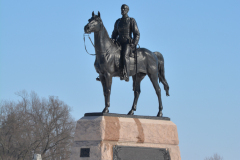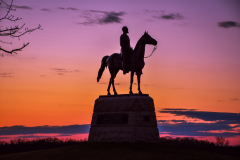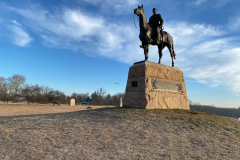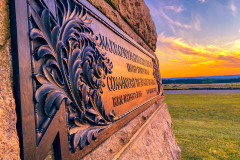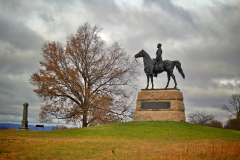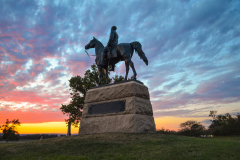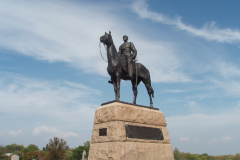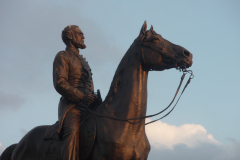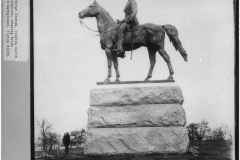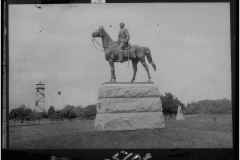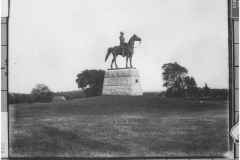Dedicated: June 5, 1896.
Location: North Hancock Avenue opposite the Angle.
Description: An equestrian portrait of General Meade looking out over the battlefield where the Union army under his direction won one of its greatest battles. He holds a pair of binoculars in his proper right hand and his hat in his proper left hand. A sword hangs from the left side of his saddle. The monument cost $37,500. Placed on the crest of Cemetery Ridge, indicates general position from which Meade oversaw repulse of Longstreet’s assault July 3, 1863, giving voice and visual encouragement to soldiers.
National Park Service List of Classified Monuments Number: MN275a
Sculptor: Henry Kirke Brown
About Maj. Gen. George Gordon Meade
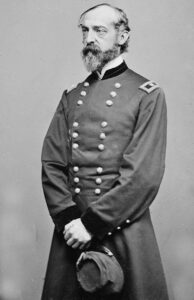 The son of a diplomat, George Meade was born on December 31, 1815 in Cadiz, Spain. He graduated from West Point in 1835 and fought in the Seminole War and Mexican War. Meade was prominent in the army’s topographical engineer corps, and he helped survey the Great Lakes as well as build lighthouses on the Atlantic Coast, especially in New Jersey.
The son of a diplomat, George Meade was born on December 31, 1815 in Cadiz, Spain. He graduated from West Point in 1835 and fought in the Seminole War and Mexican War. Meade was prominent in the army’s topographical engineer corps, and he helped survey the Great Lakes as well as build lighthouses on the Atlantic Coast, especially in New Jersey.
Meade entered the Civil War as a brigadier general of volunteers and commanded a brigade in the Pennsylvania Reserves. He was badly wounded at Glendale but resumed command in time for the Second Bull Run Campaign. His brigade’s heroic stand on Henry House Hill helped save Pope’s Army of Virginia from being destroyed.
He commanded a division at Antietam and Fredericksburg with distinction; he was elevated to corps commander at Chancellorsville. On the morning of June 28, Meade awoke to learn he was in command of the Army of the Potomac. He managed to defeat Lee decisively — something no other general had done — and won a great victory for the Union. While Lincoln was disappointed in Meade’s failure to bring Lee to battle again, Meade remained in command of the Army of the Potomac for the rest of the Civil War, although he was often forgotten beside Grant.
Meade’s nickname was “Old Snapping Turtle” and he was notable for being one of the few Catholics among the Union’s high command. He was the commander of the Division of the Atlantic at the time of his death on November 6, 1872; his lung and liver had been injured at Glendale, which left Meade prone to illness and led to his early death at just 56. Meade is buried in Philadelphia’s Laurel Hill Cemetery under a very simple stone which states “He did his work bravely and is at rest.” Meade has an active U.S. Army fort named in his honor and there are several monuments to him, including at Gettysburg, in Washington D.C., and in Philadelphia’s Fairmount Park.
Other Monuments: Meade Rock | Headquarters | Equestrian


